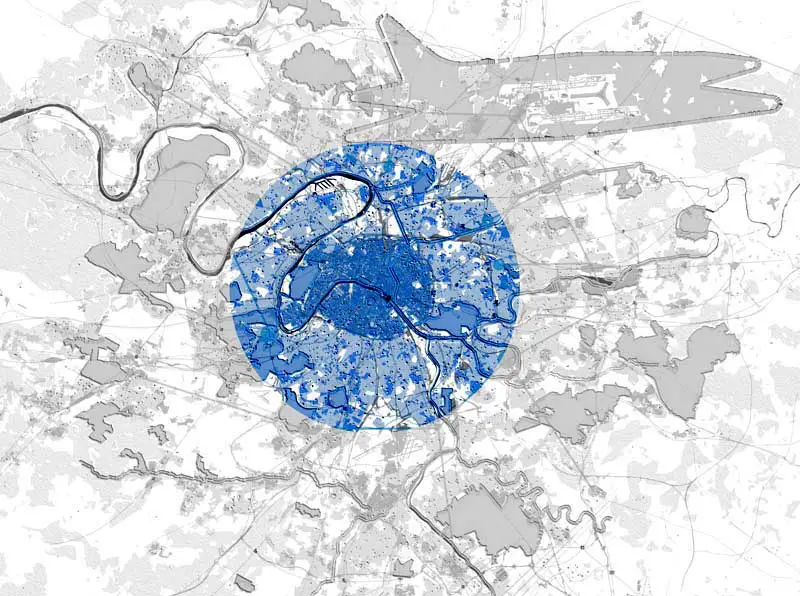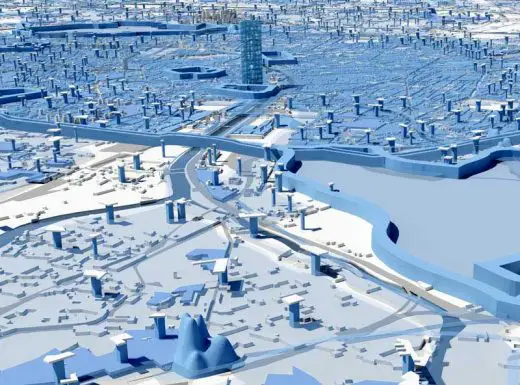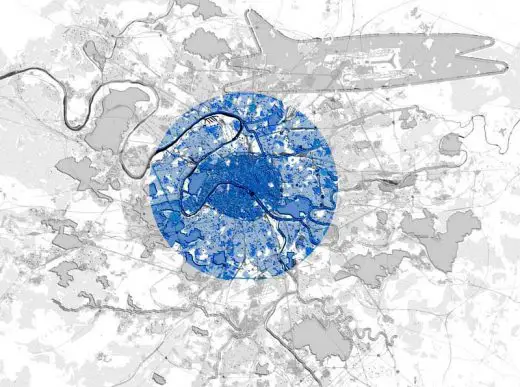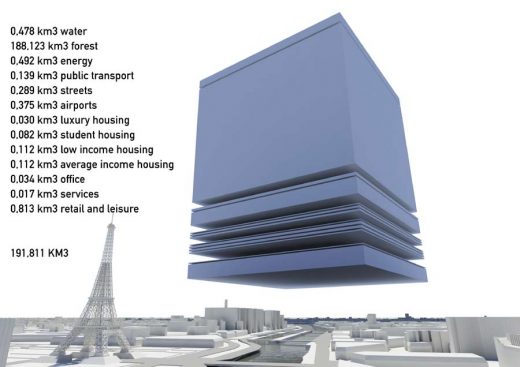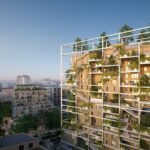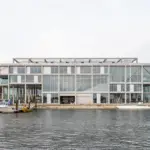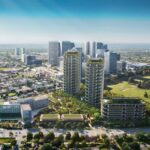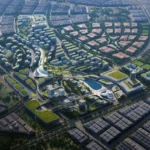Paris Plus petit vision, French Capital Masterplan Project, News, Design Images
Paris Plus petit Masterplan
Vision for the French capital design by MVRDV architects, The Netherlands
13 Mar 2009
Paris Plus petit vision
MVRDV presents vision for Greater Paris 2030
(Paris/Rotterdam, 12 March 2009): Today Winy Maas presented MVRDV’s vision for Greater Paris 2030 to the Economic and Social Council of France. The project “Paris Plus petit” by MVRDV in collaboration with ACS and AAF is one of ten proposals by international architecture and urbanism teams to envision the future of the French capital and its vast agglomeration. The urban challenge has been commissioned by Nicolas Sarkozy, President of France.
“Paris Plus” stands for more: more ambition, more optimism, more density, more efficiency, more ecology and more compactness. Greater Paris needs a strong combination of responsibility and ambition to continue its development, to ensure its consistency and to develop a cohesion that can build a base for a collective enterprise to solve its problems, to enlarge its presence and attractiveness, to create an even more remarkable, exemplary city.
MVRDV with ACS and AAF’s response for President Sarkozy’s 2009 urban planning consultation for the great challenge of the Greater Paris area is represented in four parts: the ‘Synthesis’, the ‘City Calculator©’, the ‘Data’ and the ‘Observation’.
The Synthesis defines the spatial agenda for the city, based on ambitious and responsible strategies for the French capital. It is the core of the response and proposes a series of 17 large scale interventions that are based on an analysis of the city’s fabric, its future programmatic needs and spatial possibilities. The proposals are interventions based on available space and feasible. Among them the ambition to make Paris highly accessible: the creation of a grand central station at the location of Les Halles, underground densification of the Boulevard Périphérique by adding a metro line and two underground motorways ring-roads, the creation of new Grand Axe’s and a subterranean infrastructure band along the Seine.
The space liberated by the buried infrastructure is used for a housing program that allows for urban living in pleasant and green environments. Further parts of the vision are investments into transport, nature, education, culture, social cohesion and vast amounts of renewable energy. The sum of all projects can avoid future sprawl and radically transform Paris into one of the densest, most compact and therefore sustainable high quality cities in the world: “Paris Plus petit”.
The City Calculator© is a proposed demo version of a potential software and possible webtool, which quantifies the ‘behaviour and performance’ of a city and makes it comparable to others. It connects qualitative to quantitative parameters. It can be used as a public and planning tool to support sustainable planning. The City Calculator© will be conceived in collaboration, by The Why Factory at Delft University of Technology.
The Data gives the overview of the detailed research on the functioning and performance of Greater Paris, which has been the background for the spatial proposals.
The Observations are a series of articles on the backgrounds, the history, the potentials and the problems of the French metropolis.
President Nicolas Sarkozy commissioned in June 2008 ten teams of architects and urban planners to imagine an exemplary “Grand Paris” a sustainable and boldly designed capital. The project was hailed being the most ambitious since Haussmann changed Paris in the 19th century. The challenge for the 10 teams was envisioning the European metropolis in 2030 being a “post-Kyoto” green urban centre which allows for growth beyond the current two million Parisians and provides them with attractive urban environments.
The ten plans will be presented in an exhibition at “Cité de l’Architecture” open to the public from the 29th of April 2009 until the 22nd of November 2009. www.citechaillot.fr. Images online soon.
Paris Plus petit vision information from MVRDV 120309
Le Grand Pari de l’agglomération parisienne
MVRDV was set up in Rotterdam (the Netherlands) in 1993 by Winy Maas, Jacob van Rijs and Nathalie de Vries. MVRDV produces designs and studies in the fields of architecture, urbanism and landscape design. Early projects such as the headquarters for the Dutch Public Broadcaster VPRO and housing for elderly WoZoCo in Amsterdam lead to international acclaim.
The office continues to pursue its fascination and methodical research on density using a method of shaping space through complex amounts of data that accompany contemporary building and design processes. MVRDV first published a cross section of these study results in FARMAX (1998), followed by a.o. MetaCity/Datatown (1999), Costa Iberica (2000), Regionmaker (2002), 5 Minutes City (2003), KM3 (2005), which contains Pig City and more recently Spacefighter (2007) and Skycar City (2007), the latter two will be exhibited at the 2008 Biennale of Venice. MVRDV deals with global ecological issues in large scale studies like Pig City as well as in small scale solutions for flooded areas of New Orleans.
The products of this approach vary and range from buildings of all types and sizes, to urban designs to publications and installations. Realized projects include the Dutch Pavilion for the World EXPO 2000 in Hannover, an innovative business park ‘Flight Forum’ in Eindhoven, the Silodam Housing complex in Amsterdam, the Matsudai Cultural Centre in Japan, Unterföhring office campus near Munich, the Lloyd Hotel in Amsterdam, an urban plan and housing in The Hague Ypenburg, the rooftop – housing extension Didden Village in Rotterdam, the cultural Centre De Effenaar in Eindhoven, the boutique shopping centre Gyre in Tokyo, Veldhoven’s Maxima Medical Centre and the iconic Mirador housing in Madrid. MVRDV also has a long history of working on urban visions and urban planning, both theoretical as in terms of realisations.
Current projects include various housing projects in the Netherlands, Spain, China, France, Austria, the United Kingdom, USA, Korea and other countries, a television centre in Zürich, a public library for Spijkenisse (Netherlands), a central market hall for Rotterdam, a culture plaza in Nanjing, China, large scale urban masterplans in Oslo, Norway and in Tirana, Albania, a masterplan for an eco-city in Logroño, Spain and an urban vision for the doubling in size of Almere, Netherlands.
The work of MVRDV is exhibited and published world wide and receives international awards. The 65 architects, designers and staff members conceive projects in a multi-disciplinary collaborative design process and apply highest technological and sustainable standards.
Greater Paris Vision by LIN
Location: Paris, France
New Paris Architecture
Contemporary Paris Architecture
Paris Architecture Design – chronological list
Paris Architecture Walking Tours by e-architect
Key Buildings by MVRDV
Paris Architecture – Selection
Architects: Koz architectes
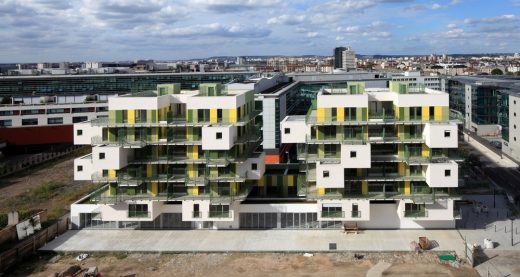
photography © Guillaume Grasset and Jean-Baptiste Pellerin
28 Social Housing Units in Courbevoie
Hermitage Plaza
Foster + Partners
Hermitage Plaza
The Phare
Morphosis, Architects
The Phare Paris
Buildings / photos for the Paris Plus petit vision – MVRDV Architecture in France page welcome

